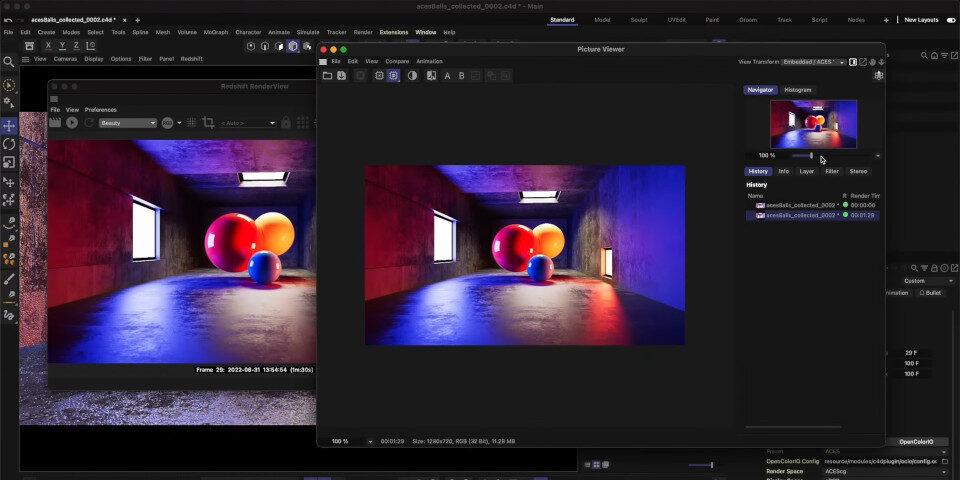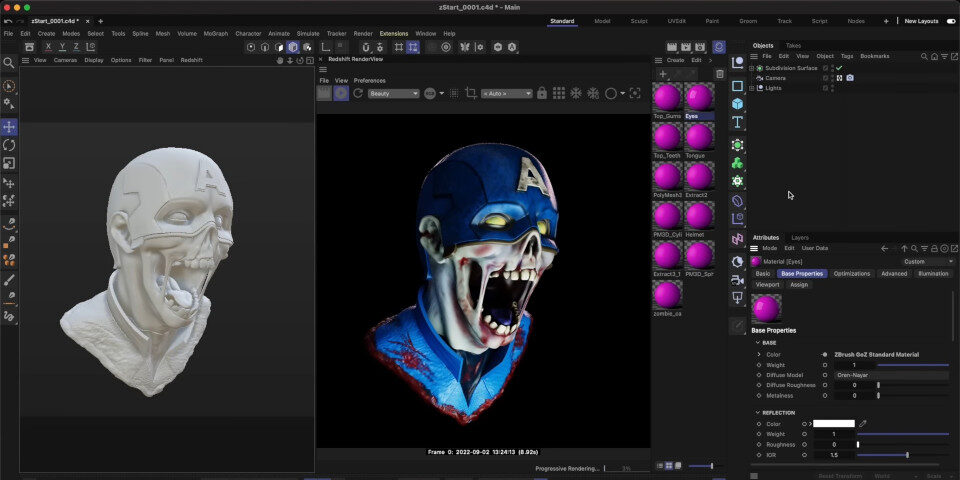Maxon has released Cinema 4D 2023, the latest version of its 3D design and animation software.
The update adds a new global symmetry system for modelling, support for soft bodies within Cinema 4D’s unified simulation framework, and native support for OpenColorIO; and improves the GoZ bridge to ZBrush.
Maxon has also ended perpetual licences for new versions of the software, meaning that the update is only available to users with subscriptions, either to Cinema 4D itself or to the Maxon One product bundle.
The release is part of a series of Fall 2022 updates to Maxon’s software, which also includes new versions of the Red Giant effects plugins, and its mobile apps Forger and Moves by Maxon.
A move to annual version numbering – and an end to perpetual licences
The first obvious change about Cinema 4D 2023 is the version number, since with the update, Maxon has switched to Autodesk-style annual versioning.
Under the previous numbering system, it would have been Cinema 4D R27, with the ‘R’ denoting that it was available as an upgrade for perpetual licence holders, unlike the subscription-only ‘S’ releases.
Although perpetual licences are still listed in Maxon’s online store, they are only available for Cinema 4D R25, the previous version of the software.
Maxon told us that Cinema 4D 2023 will not be available as a perpetual licence, and that to get access to the new features, existing perpetual licence holders would need to upgrade to a subscription.

Cinema 4D 2023’s new global symmetry system makes it possible to mirror polygonal modelling operations across any coordinate axis: something previously only possible during organic sculpting.
3D modelling: new global symmetry system
Key features in Cinema 4D 2023 itself include a new global symmetry system.
That makes symmetry available during polygonal modelling as well as sculpting, with users able to mirror edits to a model on any co-ordinate axis in object or world space, or on custom planes of symmetry.
The new system also supports asymmetrical objects that have symmetrical topology, making it possible to keep making edits to a previously symmetrical character model after it has been posed, for example.
3D modelling: use vertex maps and vertex colour data in Generators by defining them with Fields
In addition, during procedural modelling, most Generators within Cinema 4D now support Vertex Maps and Vertex Color tags if they can be controlled by Cinema 4D’s Fields system.
Polygon selections on primitives and generators can also be generated procedurally using Fields.

Cinema 4D’s unified simulation framework now supports soft bodies. Their physics properties are controlled by the length and distribution of pole constraints, shown running across the dinosaur in the image above.
Simulation: New integrated, GPU-accelerated soft body physics system
In addition, the new unified simulation framework introduced in Cinema 4D S26 for cloth and ropes has now been extended to support soft bodies in general, including plastic deformation.
The software automatically generates pole constraints within a soft body, with users able to control its physics properties by adjusting their settings, or using Fields to control their direction.
Soft bodies can interact with other objects in the scene controlled by the framework, and simulations can now be combined with keyframe animation: a workflow that Maxon calls ‘mixed animation’.
According to Maxon, the new soft body system – which is GPU-accelerated – is also significantly faster than the old Bullet-physics-based system.

Cinema 4D now supports OpenColorIO natively, with OCIO colour management applied to the 3D views, Picture Viewer and Redshift RenderView, and when picking colours or working with textures and materials.
Rendering: native OpenColorIO colour management
Cinema 4D also becomes the latest DCC tool to support colour management standard OpenColorIO (OCIO).
The default configuration comes with presets for a range of display and render colour spaces, including sRGB and the ACEScg colour space used in VFX, but studios can also use their own custom OCIO configs.
Maxon has now implemented a unified colour management pipeline based on OpenColorIO across all of its software, with Cinema 4D settings preserved when rendering in Redshift or using Magic Bullet Looks.

The updated GoZ bridge to digital sculpting software ZBrush now transfers edge crease settings and vertex weights, and can now generate Redshift materials based on ZBrush textures or Polypaint data.
Workflow: link Watch Folders to the Asset Browser, improvements to the GoZ bridge to ZBrush
Workflow improvements include Watch Folders, making it possible to display assets stored in any folder on the file system within Cinema 4D’s Asset Browser, not just those previously placed in a database.
Metadata and thumbnail images are generated on the fly, updating automatically when new files are added.
The GoZ bridge, for transfering models between Cinema 4D and digital sculpting software ZBrush, which Maxon acquired earlier this year, has also been updated.
The bridge now transfers subdivision surface edge weighting and vertex weight data, and handling of ZBrush’s Polygroups has been improved.
When importing materials from ZBrush, users can also now choose to create either standard Cinema 4D or Redshift materials, based on texture maps or ZBrush Polypaint data.
You can find a full list of changes via the links below.
https://nukedrive.com/va/Cinema_4D_2023.0.0_Win.rar
https://www.file-upload.com/v7r450yluh1e
https://1fichier.com/?zptynqs23aydtyzoylyi




















Leave a Reply
You must be logged in to post a comment.